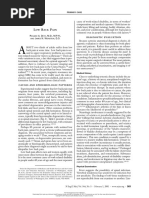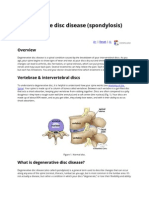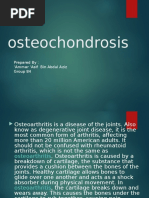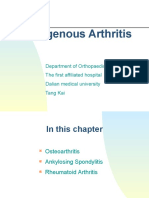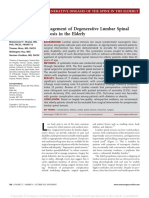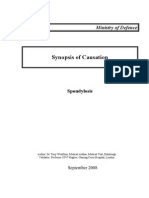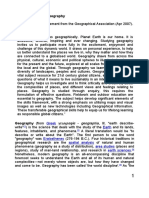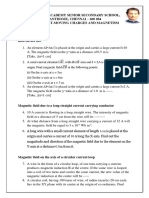Spondylosis, Degeneration of Intervertebral Disc Diagnosis/Condition: ICD-9 Codes
Spondylosis, Degeneration of Intervertebral Disc Diagnosis/Condition: ICD-9 Codes
Uploaded by
Aloysius DicodemusCopyright:
Available Formats
Spondylosis, Degeneration of Intervertebral Disc Diagnosis/Condition: ICD-9 Codes
Spondylosis, Degeneration of Intervertebral Disc Diagnosis/Condition: ICD-9 Codes
Uploaded by
Aloysius DicodemusOriginal Description:
Original Title
Copyright
Available Formats
Share this document
Did you find this document useful?
Is this content inappropriate?
Copyright:
Available Formats
Spondylosis, Degeneration of Intervertebral Disc Diagnosis/Condition: ICD-9 Codes
Spondylosis, Degeneration of Intervertebral Disc Diagnosis/Condition: ICD-9 Codes
Uploaded by
Aloysius DicodemusCopyright:
Available Formats
Spondylosis, Degeneration of Intervertebral Disc Diagnosis/Condition: Spondylosis and allied disorders Degeneration of cervical intervertebral disc Degeneration of thoracic
or lumbar intervertebral disc Origination Date: Review/Revised 11/1996 Date: 3/2008
ICD-9 Codes:
721.0, 721.2, 721.3 722.4 722.5 Next Review Date: 3/2010 Discipline: DC, ND
These diagnoses refer to conditions of the intervertebral discs caused by degenerative changes associated most commonly with the natural consequences of aging (primary) but also occasionally with post traumatic degeneration (secondary). Most studies suggest no causative relationship between the development of spondylosis and factors such as lifestyle, height, weight, body mass, physical activity, cigarette and alcohol consumption, or reproductive history. The effects of heavy physical activity are controversial in a purported relationship to disc degeneration. It is extremely common in the population. In the US, more than 80% of individuals older than 40 years have lumbar spondylosis, increasing from 3% of individuals aged 20-29 years. As the intervertebral disc ages, its hydrophyllic properties decline with resultant loss of disc height and increased mechanical instability. This results in greater tensile forces at the junction between the vertebral body margin and the outer margins of the disc and intervertebral ligaments. This in turn causes the formation of new bone excrescences seen at x-ray examination and described radiographically as osteophytes. Often referred to as degenerative disc disease and spinal osteoarthritis, it is neither uniquely pathological nor inflammatory. By itself, spondylosis (or disc degeneration) is most likely not a cause for clinical concern. For example, lumbar spondylosis is present in 27-37% of the asymptomatic population and there is no greater frequency of signs or symptoms among individuals with osteophytes than among those without them. However, spondylosis is often seen with more morbid conditions such as acute and chronic pain, myelopathy and radiculopathy. The focus of this clinical pathway is spondylosis/degeneration without myelopathy or radiculopathy. Subjective Findings and History: Loss of intervertebral disc integrity that is due to degenerative change associated with normal aging, immobilization or post-traumatic conditions Past medical history with documentation of diagnosis Age, family history Acute, subacute, or chronic spine pain. Often local, uni- or bilateral Referred limb pain and paresthesia Objective Findings: Screen for red flags Radiographic examination: Evidence of degenerative changes on X-ray Loss of normal spinal ROM Palpation for tenderness Segmental joint dysfunction/subluxation Spasm of paravertebral muscle Orthopedic and neurological examination directed at differentiating scleratogenous from neurogenic pain Discogenic stress maneuvers often reproduce the patient's low lumbar and referred symptoms. Provocative orthopedic tests MAY reproduce the pain (e.g. Straight leg raise and other tests that cause spinal motion may increase back pain)
Complementary Healthcare Plans Spondylosis Clinical Pathway
1of 4
Assessment: Disc degeneration should be considered a secondary diagnosis and may accompany an acute injury. The clinical impression should indicate the specific anatomical structures (spinal level) involved and clinically correlate them with the mechanism of injury, history, subjective complaints, and objective findings. Be alert to possible psychosocial and economic issues or personality disorders Kirkaldy-Willis described a pathophysiologic model that occurs in 3 phases of a continuum with gradual transition from one to the next. However, great variation of phases can be expected in different discs in any given individual and individuals of similar ages vary greatly. Phase I, the dysfunctional phase, is characterized histologically by circumferential tears or fissures in the outer annulus. Changes to the zygapophyseal joints during the dysfunctional phase may include synovitis and hypomobility. The facet joint may serve as a pain generator. Phase II may result from progressive loss of mechanical integrity of the trijoint complex. Discrelated changes include multiple annular tears (eg, radial, circumferential), internal disc disruption and resorption, or loss of disc-space height. Changes in the zygapophyseal joints include cartilage degeneration, capsular laxity, and subluxation. The biomechanical result of these alterations leads to segmental instability. Clinical syndromes of segmental instability, IDD syndrome, and herniated discs. Phase III, stabilization, is characterized by further disc resorption, disc-space narrowing, endplate destruction, disc fibrosis, and osteophyte formation. Discogenic pain from such discs may have a higher incidence than that of the pain from the discs in phases I and II; Plan: Spondylosis by itself may not require treatment. Spondylosis however is often associated with symptomatic conditions, for example, axial spine pain, referred pain, intersegmental dysfunction or radicular syndromes, all of which may require therapeutic intervention. An appropriate treatment plan should address the pathomechanics and clinical sequelae that attend each phase of disc degeneration as well as any associated disorder (e.g. pain, dysfunction, radicular syndrome). Passive Care: Spinal manipulation and/or mobilization with exercises Physical therapy modalities Medications: OTC NSAIDS, mild analgesics, herbal medicines Supplementation. Active Care: Education is one of the most important components of any back-care program and should include an explanation of the natural history of acute, subacute, and chronic disc problems Weight loss when indicated Active exercise for mobility and strength Posture training Activity/work restriction, if appropriate Smoking cessation. Length of Treatment: Conservative therapy: 3-6 months. Referral Criteria: Referral to an appropriate non-surgical spine specialist if no improvement noted after 6-8 weeks Consultation with a spine surgeon may be appropriate for patients with intractable severe function-limiting symptoms, for those with symptoms lasting longer than 6 months who
Complementary Healthcare Plans Spondylosis Clinical Pathway
2of 4
have had no relief from nonsurgical approaches, and for persons with abnormal neurologic findings.
Practitioner Resources: eMedicine from WebMD. Lumbar spondylosis. Bruce M Rothschild, MD http://www.emedicine.com/med/topic2901.htm eMedicine from WebMD. Lumbar degenerative disc disease. Rajeev K Patel, MD. http://www.emedicine.com/PMR/topic67.htm Patient Resources: The Evidence: Calliet R: Neck pain and disability. (incomplete) Kirkaldy-Willis W: Managing low back pain. Churchill-Livingstone, New York, 1992. Souza T: Differential diagnosis for the chiropractor. Aspen Publishers, Gaithersburg, MD, 1997. Bogduk N, Twomey LT. Clinical Anatomy of the Lumbar Spine. 2nd ed. London: Churchill Livingstone;1991. Nerlich, A.G.; Schleicher, E.D.; Boos, N.; 1997 Volvo Award Winner in Basic Science Studies: Immunohistologic Markers for Age-Related Changes of Human Lumbar Intervertebral Discs. SPINE. 1997 DEC Vol. 22(24) Pgs. 2781-95 Freemont AJ, Peacock TE, Goupille P, et al. Nerve ingrowth into diseased intervertebral disc in chronic back pain. Lancet. Jul 19 1997;350(9072):178-81. Mayer TG, Gatchel RJ, Kishino N, et al. Objective assessment of spine function following industrial injury: a prospective study with comparison group and one-year follow-up. Spine. JulAug 1985;10(6):482-93. Akmal, M.; Kesani, A.; Anand, B.; Singh, A.; Wiseman, M.; Goodship, A.; Effect of Nicotine on Spinal Disc Cells: A Cellular Mechanism for Disc Degeneration. SPINE. 2004 MAR Vol. 29(5) Pgs. 568-75 Stokes, I.A.; Iatrindis, J.C.; Mechanical Conditions That Accelerate Intervertebral Disc Degeneration: Overload Versus Immobilization. SPINE. 2004 DEC Vol. 29(23) Pgs. 2724-32 Battie, M.C.; Videman, T.; Parent, E.; Lumbar Disc Degeneration: Epidemiology and Genetic Influences. SPINE. 2004 DEC Vol. 29(23) Pgs. 2679-90 Haughton, V.; Medical Imaging of Intervertebral Disc Degeneration: Current Status of Imaging. SPINE. 2004 DEC Vol. 29(23) Pgs. 2751-56 Gross, A.R.; Hoving, J.L.; Haines, T.A.; Goldsmith, C.H.; Kay, T.; Aker, P.; Bronfort, G.; A Cochrane review of manipulation and mobilization for mechanical neck disorders. SPINE. 2004 JUL Vol. 29(14) Pgs. 1541-8 Borenstein D. Does osteoarthritis of the lumbar spine cause chronic low back pain?. Curr Rheumatol Rep. Feb 2004;6(1):14-9. Clinical Pathway Feedback
Complementary Healthcare Plans Spondylosis Clinical Pathway
3of 4
CHP desires to keep our clinical pathways customarily updated. If you wish to provide additional input, please click on the email address listed below and identify which clinical pathway you are referencing. Thank you for taking the time to give us your comments. Chuck Simpson, DC, CHP Medical Director: csimpson@chpgroup.com
Complementary Healthcare Plans Spondylosis Clinical Pathway
4of 4
You might also like
- Chronic Musculoskeletal Pain in Young Athletes: Eric Small, MDNo ratings yetChronic Musculoskeletal Pain in Young Athletes: Eric Small, MD8 pages
- Dokumen - Tips - Lumbar Spondylolisthesis PPT 4No ratings yetDokumen - Tips - Lumbar Spondylolisthesis PPT 423 pages
- Condiciones ortopédicas en PC CNA 2020No ratings yetCondiciones ortopédicas en PC CNA 202013 pages
- 2021 Medicare Imaging Study (Spine Degeneration)No ratings yet2021 Medicare Imaging Study (Spine Degeneration)11 pages
- Spondylosis Vs Spondylolysis Vs SpondylolisthesisNo ratings yetSpondylosis Vs Spondylolysis Vs Spondylolisthesis6 pages
- Spontaneous Regression of A Large Lumbar Disc Extrusion: WWW - Jkns.or - KRNo ratings yetSpontaneous Regression of A Large Lumbar Disc Extrusion: WWW - Jkns.or - KR3 pages
- Lumbar Degenerative Disk Disease - StatPearls - NCBI BookshelfNo ratings yetLumbar Degenerative Disk Disease - StatPearls - NCBI Bookshelf6 pages
- Epidemiology, Diagnosis, and Treatment of Temporomandibular DisordersNo ratings yetEpidemiology, Diagnosis, and Treatment of Temporomandibular Disorders16 pages
- Neurosurgery Cases and Reviews NCR 4 056No ratings yetNeurosurgery Cases and Reviews NCR 4 05611 pages
- Degenerative Joint Diseases - Admisson ExamNo ratings yetDegenerative Joint Diseases - Admisson Exam23 pages
- Apyogenous Arthritis: Department of Orthopaedics The First Affiliated Hospital Dalian Medical University Tang KaiNo ratings yetApyogenous Arthritis: Department of Orthopaedics The First Affiliated Hospital Dalian Medical University Tang Kai131 pages
- Natural History: Changes in Disc Structure With Aging and DegenerationNo ratings yetNatural History: Changes in Disc Structure With Aging and Degeneration11 pages
- Clinical Examination Hip Joint Athletes 2009No ratings yetClinical Examination Hip Joint Athletes 200912 pages
- Pathophysiology, Diagnosis, and Treatment of Discogenic Low Back PainNo ratings yetPathophysiology, Diagnosis, and Treatment of Discogenic Low Back Pain11 pages
- Management of Degenerative Lumbar Spinal Stenosis in The ElderlyNo ratings yetManagement of Degenerative Lumbar Spinal Stenosis in The Elderly7 pages
- Nurul Hudayani C 111 06 100 Supervisor Dr. Muh. Andry Usman, SP - OTNo ratings yetNurul Hudayani C 111 06 100 Supervisor Dr. Muh. Andry Usman, SP - OT14 pages
- Mysterious Femur Fracture in An Aged Man BackgroundNo ratings yetMysterious Femur Fracture in An Aged Man Background5 pages
- A. Pusey Murray (MRS) RN, Cert Psych Nursing & Nursing Admin, BSC (Hons), MPH, Dip. Ed. PHD (C)No ratings yetA. Pusey Murray (MRS) RN, Cert Psych Nursing & Nursing Admin, BSC (Hons), MPH, Dip. Ed. PHD (C)31 pages
- DUSCHENE MUSCLE DYSTROPHY AND MYOPATHIESNo ratings yetDUSCHENE MUSCLE DYSTROPHY AND MYOPATHIES38 pages
- I. Cervical Spondylosis (British Medical Journal, Best Practice) PathophysiologyNo ratings yetI. Cervical Spondylosis (British Medical Journal, Best Practice) Pathophysiology6 pages
- Osteoarthritis: Natural Drugless Treatments That Really Work!From EverandOsteoarthritis: Natural Drugless Treatments That Really Work!No ratings yet
- Disease. 7th Ed. Philadelphia, Pa: Saunders Elsevier 2009:chap 273No ratings yetDisease. 7th Ed. Philadelphia, Pa: Saunders Elsevier 2009:chap 2731 page
- AWS API-M:2006 Study Guide For API Standard 1104, Twentieth Edition Exercise OuestionsNo ratings yetAWS API-M:2006 Study Guide For API Standard 1104, Twentieth Edition Exercise Ouestions27 pages
- Classroom Management Strategies For Effective Teaching and Learning in Universities in Rivers State, NigeriaNo ratings yetClassroom Management Strategies For Effective Teaching and Learning in Universities in Rivers State, Nigeria23 pages
- Foundation to Reading 1 (Đọc hiểu cơ bản 1) Luyện tập trắc nghiệm 2 - Ngôn ngữ Anh100% (1)Foundation to Reading 1 (Đọc hiểu cơ bản 1) Luyện tập trắc nghiệm 2 - Ngôn ngữ Anh8 pages
- Rochester Fiber Internet Feasibility StudyNo ratings yetRochester Fiber Internet Feasibility Study50 pages
- Strategic Management (Internal Environment)No ratings yetStrategic Management (Internal Environment)14 pages
- Colleen 2019 The Construct Validation of The Math Anxiety Scale For TeachersNo ratings yetColleen 2019 The Construct Validation of The Math Anxiety Scale For Teachers16 pages
- Soft Robotics: The Next Generation of Intelligent MachinesNo ratings yetSoft Robotics: The Next Generation of Intelligent Machines7 pages
- Currently Tracking: MOS 2016 Study Guide For Microsoft ExcelNo ratings yetCurrently Tracking: MOS 2016 Study Guide For Microsoft Excel6 pages
- Jindal Institute of Power Technology: Post Graduate Diploma Course (PGDC) in PowerNo ratings yetJindal Institute of Power Technology: Post Graduate Diploma Course (PGDC) in Power2 pages
- Geometric Modeling For Swept Volume of Moving Solids: BITS PilaniNo ratings yetGeometric Modeling For Swept Volume of Moving Solids: BITS Pilani13 pages
- Chronic Musculoskeletal Pain in Young Athletes: Eric Small, MDChronic Musculoskeletal Pain in Young Athletes: Eric Small, MD
- Spontaneous Regression of A Large Lumbar Disc Extrusion: WWW - Jkns.or - KRSpontaneous Regression of A Large Lumbar Disc Extrusion: WWW - Jkns.or - KR
- Lumbar Degenerative Disk Disease - StatPearls - NCBI BookshelfLumbar Degenerative Disk Disease - StatPearls - NCBI Bookshelf
- Epidemiology, Diagnosis, and Treatment of Temporomandibular DisordersEpidemiology, Diagnosis, and Treatment of Temporomandibular Disorders
- Apyogenous Arthritis: Department of Orthopaedics The First Affiliated Hospital Dalian Medical University Tang KaiApyogenous Arthritis: Department of Orthopaedics The First Affiliated Hospital Dalian Medical University Tang Kai
- Natural History: Changes in Disc Structure With Aging and DegenerationNatural History: Changes in Disc Structure With Aging and Degeneration
- Pathophysiology, Diagnosis, and Treatment of Discogenic Low Back PainPathophysiology, Diagnosis, and Treatment of Discogenic Low Back Pain
- Management of Degenerative Lumbar Spinal Stenosis in The ElderlyManagement of Degenerative Lumbar Spinal Stenosis in The Elderly
- Nurul Hudayani C 111 06 100 Supervisor Dr. Muh. Andry Usman, SP - OTNurul Hudayani C 111 06 100 Supervisor Dr. Muh. Andry Usman, SP - OT
- Mysterious Femur Fracture in An Aged Man BackgroundMysterious Femur Fracture in An Aged Man Background
- A. Pusey Murray (MRS) RN, Cert Psych Nursing & Nursing Admin, BSC (Hons), MPH, Dip. Ed. PHD (C)A. Pusey Murray (MRS) RN, Cert Psych Nursing & Nursing Admin, BSC (Hons), MPH, Dip. Ed. PHD (C)
- I. Cervical Spondylosis (British Medical Journal, Best Practice) PathophysiologyI. Cervical Spondylosis (British Medical Journal, Best Practice) Pathophysiology
- Osteoarthritis: Natural Drugless Treatments That Really Work!From EverandOsteoarthritis: Natural Drugless Treatments That Really Work!
- Disease. 7th Ed. Philadelphia, Pa: Saunders Elsevier 2009:chap 273Disease. 7th Ed. Philadelphia, Pa: Saunders Elsevier 2009:chap 273
- AWS API-M:2006 Study Guide For API Standard 1104, Twentieth Edition Exercise OuestionsAWS API-M:2006 Study Guide For API Standard 1104, Twentieth Edition Exercise Ouestions
- Classroom Management Strategies For Effective Teaching and Learning in Universities in Rivers State, NigeriaClassroom Management Strategies For Effective Teaching and Learning in Universities in Rivers State, Nigeria
- Foundation to Reading 1 (Đọc hiểu cơ bản 1) Luyện tập trắc nghiệm 2 - Ngôn ngữ AnhFoundation to Reading 1 (Đọc hiểu cơ bản 1) Luyện tập trắc nghiệm 2 - Ngôn ngữ Anh
- Colleen 2019 The Construct Validation of The Math Anxiety Scale For TeachersColleen 2019 The Construct Validation of The Math Anxiety Scale For Teachers
- Soft Robotics: The Next Generation of Intelligent MachinesSoft Robotics: The Next Generation of Intelligent Machines
- Currently Tracking: MOS 2016 Study Guide For Microsoft ExcelCurrently Tracking: MOS 2016 Study Guide For Microsoft Excel
- Jindal Institute of Power Technology: Post Graduate Diploma Course (PGDC) in PowerJindal Institute of Power Technology: Post Graduate Diploma Course (PGDC) in Power
- Geometric Modeling For Swept Volume of Moving Solids: BITS PilaniGeometric Modeling For Swept Volume of Moving Solids: BITS Pilani


